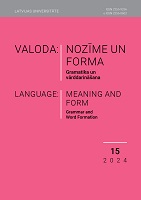Substantīvu piedēkļu -in- un -īn- lietojums Būtiņģes un Sventājas latviešu valodā
The use of substantives’ suffixes -in- and -īn- in the Latvian language of Būtingė and Šventoji
Author(s): Daiga StraupenieceSubject(s): Morphology, Baltic Languages, Philology
Published by: Latvijas Universitātes Akadēmiskais apgāds
Keywords: substantives; suffixes; word-formation; word’s meaning; subdialect; Būtingė; Šventoji;
Summary/Abstract: Lower Kurzeme subdialects contain many productive word-formation suffixes, such as -el-, -en-, -n-, -ien-, -in-, -īn-, -īt-. The Latvian language of Būtingė and Šventoji, which today belongs to the Latvian (Curonian) cultural space in the north-west of Lithuania at the Baltic Sea, with its cultural and historical traditions, also belongs both to Rucava cultural space and broader cultural and linguistic scenery of Lower Kurzeme. The article reflects the research dedicated to the dynamics of the two most productive word-formation suffixes, -in- and -īn-, in the Latvian language of Būtingė and Šventoji, noting the common traits with Lower Kurzeme subdialects and emphasising the features and quantitative indicators which are different. The material of research consists of the language recordings (2008–2021) from Būtingė and Šventoji, which were decoded by the author, and the language examples from Kurzeme Institute of Humanities expeditions published in the book “From Šventoji to Ance” (2008). The research material also includes the decodings of the 21st-century language of people from Būtingė and Šventoji who moved to Latvia in the 1960s. The main research methods used in the study are the analytical method and the comparative method. All substantives with suffixes -in- and -īn- were excerpted. The comparative method was used to examine the intensity of use of the substantives with suffixes -in- and -īn- in the older, middle, and younger generations in different thematic groups and compare the language material with Lower Kurzeme subdialects and the north-western subdialects of the Lithuanian language’s Samogitian dialect. The study has yielded a conclusion that substantives with the suffixes -in- and -īn- are mainly words of neutral meanings that do not express the meaning of a diminutive; their use at the beginning of the 21st century in the Latvian language of Būtingė and Šventoji is common in the language of the older and middle generations. A large part of derivatives with the suffix -in- in the Latvian language of Būtingė and Šventoji are personal names derived from masculine personal names.
Journal: Valoda: nozīme un forma
- Issue Year: 2024
- Issue No: 15
- Page Range: 198-209
- Page Count: 12
- Language: Latvian

